|
Definition:
Urinary tract infection is the presence of bacteria
in urine, kidney, urinary bladder, urethra or prostate.
UTI is one of the most common infections in the elderly.
Urinary catheter (tube inserted through the urethra
to drain urine from the bladder to urine collecting
bag).
Urinary tract infection may occur when the elderly patient
catheterized for a prolonged period (>2 weeks). The
colonized organisms may invade the mucosa of the urinary
bladder and cause bacteriuria, cystitis and may cause
bacteremia.
Types
of urinary catheters:
1. Indwelling catheters (urethral or suprapubic) can
be used for short and long term catheterization.
2. External catheters e.g. (condom catheters) used for
men with dementia and pressure sores and have lower
risk of infection.
3. Intermittent catheterization is used for short periods
post surgically and in rehabilitation after spinal cord
injury, and will be removed after emptying the urinary
bladder.
Causes
of UTI during urinary catheterization:
Urinary tract infection is a common disease in elderly
patients. The prevalence of UTI approaches 40 % of nosocomial
infections. According to the landmark studies 10-27%
of the catheterized patients will develop bacteriuria
within 5 days of hospitalization, 4% of the catheter
related UTI will develop bacteremia. Most patients with
long term urinary catheters are elderly.
There are many causes for contracting UTI in elderly,
especially diabetics and immune compromised patients;
among these are contamination and colonization of bacteria
following urinary catheter insertion, residual urine
in the collecting urine bags, bacteria from the bowel
and backward flow from the catheter to urinary bladder.
UTI can be life threatening and cause severe complications
in elderly. These can be prevented or reduced if proper
hygiene is followed during and after insertion of urinary
catheters and if the symptoms are discovered and treated
early.
The most common bacteria that
causes UTI in elderly are E-coli, Pseudomonas, candida
albicans staphylococcus and enterococcus species.
Proteus and pseudomonas are the common causes of biofilm
growth on the urinary catheters.
Many complications can occur
as a result of urinary catheterization; among these
are urinary tract infections, obstruction of the catheter,
urinary calculi, local trauma, bladder fibrosis, prostatitis,
pyelonephritis, local infection e.g. urethritis, local
abscesses, tubule-interstitial nephritis.
Background:
This is a retrospective study of the need for antibiotic
prophylaxis for preventing UTI following urinary catheter
insertion in the home care services and skilled nursing
facility from 1st of May 2011 till 1st of May 2012.
The goal
of the study:
To evaluate the need of using prophylactic antibiotics
before or after the insertion of urinary catheters.
Epidemiology:
Place: Home Care, Skilled Nursing Facility, Doha,
Qatar.
Duration: 12 months.
Date: 1st of May 2011 - 1st May 2012.
Patients number: 100
Method of data collection: patients' files.
Method of diagnosis: The criteria that has been
used for the diagnosis of UTI depended on symptoms like
fever, abdominal pain, decreased urine output, change
of urine color, hematuria and lab works like CBC, Urine
routine and culture.
Figure 1. Total number of the patients is 100 out
of which 55 males and 45 females
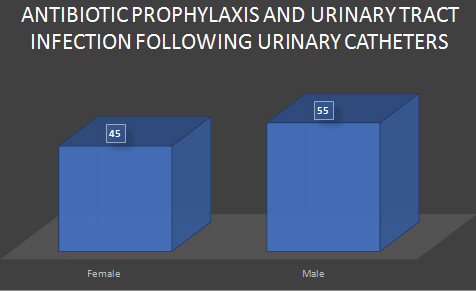
Figure 2. shows the various
reasons for urinary catheterization.
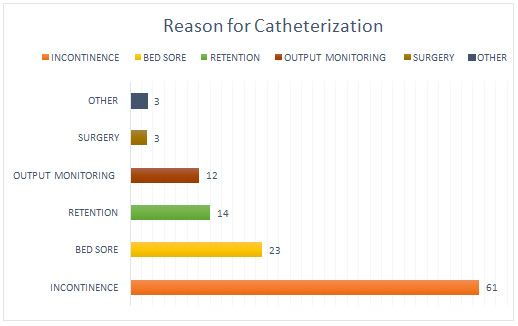
The most common reason for catheterization is incontinence
and bed sores protection.
Figure 3. shows the duration of urinary catheterization.
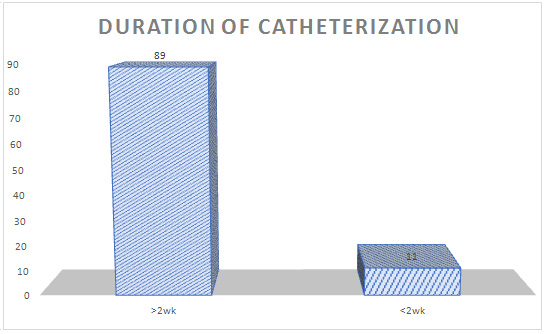
Most of the patients were on long term catheterization
for more than 2 weeks.
Figure 4. shows the number of patients who used prophylactic
antibiotics.

Figure 5. Illustrates the number of patients who
suffered UTI after insertion of catheterization in the
study.
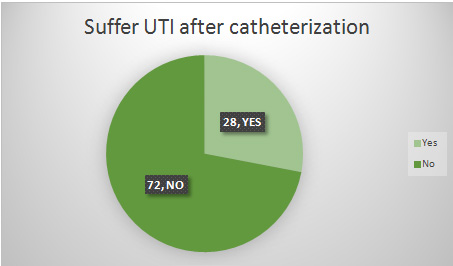
Most of the patients who suffered UTI were catheterized
for a prolonged period (more than 2 weeks) which is
also illustrated in Figures 7 and 9.
Table 1. Illustrates male and female elderly patients
who developed UTI after insertion of urinary catheter.

It also showed the duration of catheterization and type
of organism found in urine culture.
Figure 6. Illustrates the UTI causative organisms
in male patients.
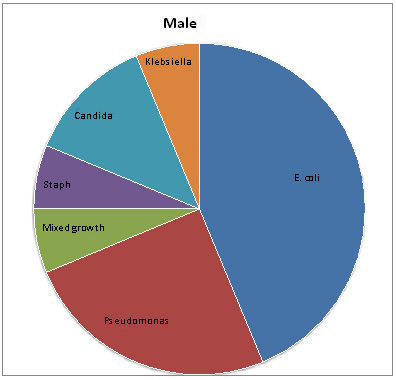
Figures 6 and 8 show the causative organisms of UTI
in catheterized patients.
It shows E-Coli as the main cause in both males and
females.
3 patients out of 28 have developed UTI even after receiving
antibiotics prophylaxis.
Figure 7. Shows the duration of urinary catheterization
in male patients who developed UTI.
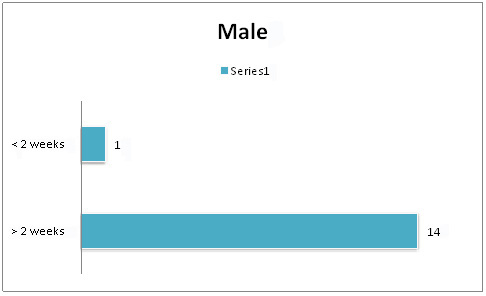
Figure 8. Shows the causative organisms in female
patients who developed UTI.

Figure 9. Shows the duration of urinary catheterization
in female patients with UTI.
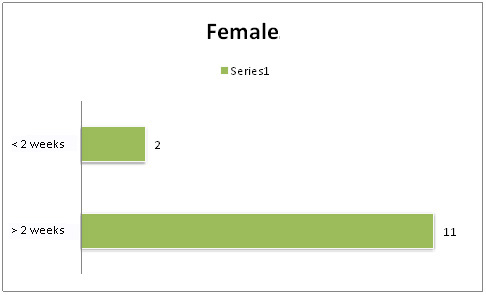
Figure 10. Shows number of patients who developed
UTI with or without antibiotics prophylaxis.

Summary:
Urinary catheterization is a common procedure in the
elderly population especially in long term facilities.
Urinary tract infection is a common disease in the elderly.
The catheterized patients are prone to develop UTI especially
with long term catheterization.
e.g. prolonged catheterization more than 2 weeks.
Prophylactic antibiotic use is not necessary to prevent
UTI in case of catheter insertion in elderly.
Bacterial colonization is common in catheterized patients
and this can lead to bacteriuria UTI and bacteremia.
UTI can be prevented if aseptic technique is used while
inserting urinary catheter then followed with proper
hygiene.
The most common organisms infecting urinary tract in
catheterized patients are E-Coli, pseudomonas and candida
albicans.
Strategies to decrease UTI during catheterization:
1. Aseptic technique during insertion and removal.
2. Daily catheter care e.g. cleans the skin around
the tube.
3. Short term catheterization.
4. Remove the urinary catheter if no clear indication.
5. Proper regular urine bag emptying.
6. Prevent the urinary catheter kinking.
7. Keep the urine collecting bag below the level
of the bladder.
8. Proper hand hygiene.
9. Replace the urine catheter regularly every
month.
|

